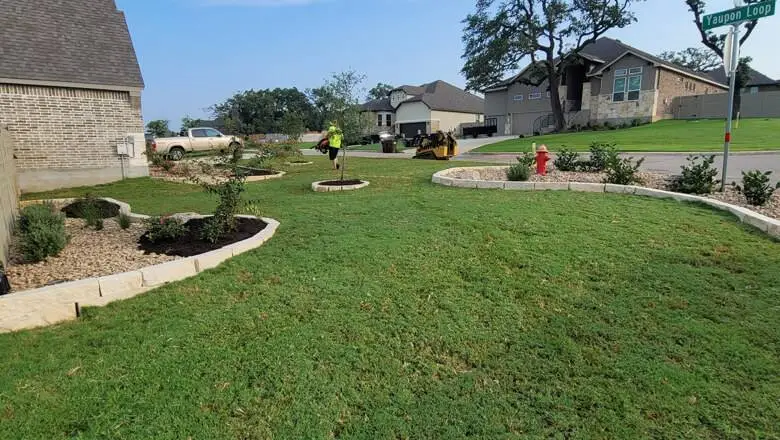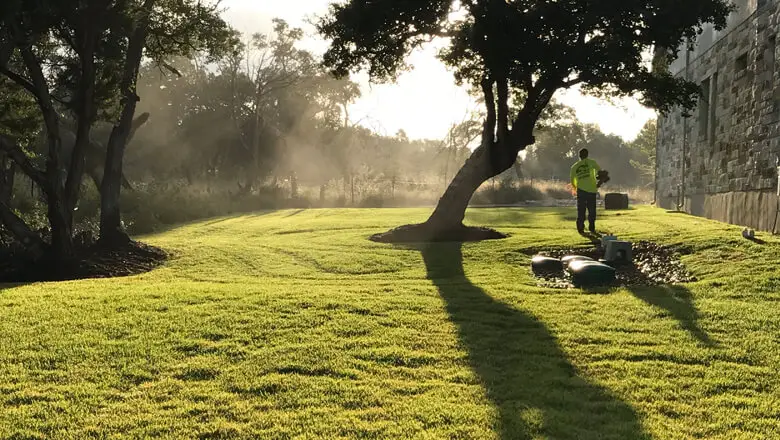Have you ever walked out to your backyard and felt sad because your lawn was filled with dull, yellow grass? No one would like it. Will you?
As you know, Texas’s harsh winter winds and freezing temperatures can make even the most vibrant landscapes appear dull and lifeless. No need for despair! Spring is a period of renewal, and with some work and residential lawn care, you can turn your weary yard into a verdant oasis.
This comprehensive guide offers everything you need for your spring cleaning project, whether you’re an experienced homeowner or new to seasonal lawn care. We’ll cover the importance of a healthy lawn, provide a detailed spring clean-up checklist, and offer tips on creating a vibrant outdoor space.
The Importance of Spring Clean-Up
Beyond simply boosting your curb appeal, a well-maintained lawn offers a multitude of benefits. A healthy lawn acts as a natural filter, removing pollutants from the air we breathe. It also helps regulate soil temperature, preventing erosion and promoting healthy plant growth. A lush green lawn can even decrease cooling costs in the summer months.
But winter’s harsh conditions can wreak havoc on a lawn. Dead leaves and debris block sunlight and prevent water from reaching the roots. Harsh winds and freezing temperatures can damage the grass and make it susceptible to disease and pests. Spring clean-up is essential for removing these harmful elements and creating a foundation for healthy growth.
DIY vs. Professional Help
The decision of whether to tackle spring clean-up yourself or hire a professional depends on several factors. If you have a small lawn and are comfortable with basic gardening tasks, then a DIY approach might be a good fit. However, if your lawn is large and heavily damaged, or you lack the time or expertise, then professional help is the smarter option. Here are some things to consider:
- Size and Complexity of Your Lawn: Larger and more complex lawns require more time and effort to maintain.
- Your Physical Abilities: Spring clean-up can involve heavy lifting and strenuous activity.
- Knowledge and Experience: If you lack basic lawn care knowledge, a professional can provide valuable expertise.
- Budget: Professional lawn maintenance services come at a cost, but they can save you time and effort in the long run.
No matter which approach you choose, this guide will provide you with the information you need to achieve a healthy and beautiful lawn with residential lawn care in Texas.

Spring Clean-Up Checklist: Waking Up Your Lawn
Now that you’re aware of why spring clean-up is crucial, let’s get started! This comprehensive checklist will guide you through each step of the process, ensuring a revitalized lawn is ready for the warm months ahead.
Clearing the Debris:
The first step is to clear away the debris that has accumulated over winter. This will allow sunlight and air to reach the soil, promoting new growth.
Leaf and Twig Removal: Grab your rake and start by removing fallen leaves, twigs, and any other debris blanketing your lawn. Consider using a leaf blower for larger areas or stubborn leaves clinging to trees and shrubs.
Pro Tip: Don’t just bag and discard your leaves! Shred them with a lawn mower and use them as a natural mulch for your flower beds. This will help retain moisture, suppress weeds, and add valuable nutrients to the soil.
Dethatching for a Healthy Breath: Dethatching is the process of removing a layer of dead grass and organic matter that accumulates at the base of the grass blades. This layer, called thatch, can prevent water and nutrients from reaching the roots. While not always necessary, dethatching can be beneficial for compacted lawns or those with heavy thatch buildup. A dethatching rake can be used for smaller areas, while larger lawns might require a rented dethatcher.
Important Note: Dethatching can be stressful for your lawn, so it’s best to dethatch only when necessary and during the appropriate time of year (usually in early spring or fall, depending on your climate).
Safe Disposal of Yard Waste: Once you’ve collected leaves, twigs, and thatch, dispose of them properly. Many municipalities offer yard waste collection services. You can also compost yard waste to create nutrient-rich fertilizer for your garden.
Cleaning Up Winter Leftovers:
Spring clean-up extends beyond just the lawn. Take a walk around your yard and address any lingering winter debris:
- Remove holiday decorations and winter clutter like outdoor furniture covers.
- Check for any winter damage to fences, patios, walkways, or outdoor furniture. Address minor repairs before they turn into bigger problems.
Preparing the Soil: The Foundation for Growth
A healthy lawn starts with healthy soil. Understanding your soil’s composition is crucial before planting seeds or applying fertilizer.
The Power of Soil Testing: A soil test will reveal your soil’s pH level (acidity or alkalinity) and nutrient content. Knowing your soil’s pH is essential for choosing the right fertilizer and amendments. Simple soil test kits are readily available at most garden centers.
Pro Tip: Contact your local cooperative extension office for information on free or low-cost soil testing in your area.
Amending Your Soil for Success: Based on your soil test results, you may need to amend your soil to improve its structure and nutrient content. Common amendments include:
- Compost: A natural soil conditioner rich in organic matter and nutrients.
- Manure: It Provides organic matter and nutrients, but needs to be aged properly before applying to avoid burning your grass.
- Lime: Raises soil pH for lawns that are too acidic.
How to Amend Your Soil: Spread the chosen amendment evenly over the lawn and rake it lightly to distribute it throughout the top few inches of soil. Follow the application instructions on the product label for best results.

Waking Up the Grass: Seeding, Feeding, and Mowing
Now that you’ve cleared the debris and prepped the soil, it’s time to focus on the star of the show – your lawn!
Seeding and Sodding for Bare Patches:
If your lawn has bare patches or thin areas, spring is the perfect time to address them. You can choose between two main options: seeding or sodding.
Seeding: A more budget-friendly option, seeding involves spreading grass seed over the bare patches. Choose a grass type suitable for your climate and sun exposure. Prepare the soil by raking it to create a smooth seedbed. Spread the seeds evenly and lightly cover them with soil. Keep the seeded area consistently moist until the grass germinates, which typically takes 7-14 days.
Pro Tip: Aerate compacted soil before seeding to improve drainage and seed-to-soil contact.
Sodding: For faster results and a more established look, consider sodding. Sod is pre-grown turfgrass that is laid down on the prepared soil surface. Sodding requires careful preparation of the soil base and proper watering to ensure successful establishment.
Feeding Your Lawn with Fertilizer:
Just like us, lawns need proper nutrition to thrive. Based on your soil test results and grass type, spring is a good time to apply a balanced fertilizer.
- Understanding Fertilizer Types: Fertilizers come in various formulations with different ratios of nitrogen (N), phosphorus (P), and potassium (K). These three elements are essential for healthy grass growth.
- Applying Fertilizer Wisely: Follow the application instructions on the fertilizer label carefully. Over-fertilization can damage your lawn and pollute the environment.
Mowing for a Healthy Cut:
Regular mowing is crucial for maintaining a healthy and attractive lawn. Here are some key points to remember:
- Mow at the Right Height: The ideal mowing height varies depending on your grass type. Generally, it’s best to mow higher in the summer months to help retain moisture and shade the soil.
- Sharpen Your Blades: Dull mower blades tear grass blades, making them susceptible to disease. Sharpen your mower blades regularly for a clean and healthy cut.
- Don’t Remove More Than ⅓ of Grass Blade: With each mowing session, avoid removing more than a third of the grass blade at a time. This promotes healthy growth and prevents your lawn from becoming stressed.

Addressing Common Lawn Issues: Weeds, Pests, and Diseases
Unfortunately, a healthy lawn can still attract unwanted guests like weeds, pests, and diseases. Here’s how to identify and combat these lawn invaders:
Conquering the Weeds:
- Know Your Enemy: Identify the types of weeds plaguing your lawn. Broadleaf weeds have wide, flat leaves, while grassy weeds resemble your lawn grass but grow in unwanted areas.
- Natural vs. Chemical Solutions: For small weed infestations, consider natural methods like hand-pulling or using vinegar. For larger infestations, consult with our residential lawn care professionals about selective herbicides. Always follow application instructions carefully when using herbicides.
Protecting Your Lawn from Pests:
- Be a Pest Detective: Look for signs of common pests like grubs and chinch bugs. These pests can damage grassroots and leave unsightly brown patches.
- Organic and Non-Organic Pest Control: Organic methods like beneficial nematodes can help control some pests. For severe infestations, consider using insecticidal products specifically designed for lawn grubs or chinch bugs.
Combating Lawn Diseases:
- Spotting the Signs: Fungal diseases like brown patches or dollar spots can cause circular brown patches on your lawn.
- Prevention and Treatment: Proper watering practices, mowing at the correct height, and good air circulation can help prevent diseases. Fungicides can be used to treat existing fungal diseases, but consult a professional for proper diagnosis and treatment recommendations.
- Additional Spring Touches: Planting, Mulching, and Enhancing Your Outdoor Space.
With a healthy lawn as your foundation, you can now add some finishing touches to create a truly beautiful and inviting outdoor space.
Planting and Mulching for Visual Appeal:
- Choosing the Right Plants: Select plants that thrive in your climate and match the amount of sunlight available in different areas of your yard.
- The Power of Mulch: Applying a layer of mulch around flower beds, trees, and shrubs offers several benefits. Mulch helps retain moisture in the soil, suppresses weeds, and adds a decorative touch to your landscape. Choose organic mulch options like shredded bark or wood chips for an eco-friendly approach.
Pro Tip: Create a visually appealing border between your lawn and flower beds with edging stones or bricks.
Edging and Trimming for a Polished Look:
- Define Your Edges: Edging creates a clean and crisp line between your lawn and flower beds, walkways, or driveways. Use a garden edger or a sharp spade to achieve a straight, defined edge.
- Shape Up Your Shrubs and Trees: Regularly trimming shrubs and trees promotes healthy growth and maintains their desired shapes.
Outdoor Furniture and Décor:
- Spring Cleaning Your Outdoor Haven: Spring-clean your outdoor furniture by removing dirt, debris, and cobwebs. Wash cushions and give your furniture a fresh coat of paint or stain if needed.
- Adding Personality with Décor: Personalize your outdoor space with planters, flower pots, garden art, and comfortable seating. String lights or hanging lanterns can create a magical ambiance in the evenings.
Conclusion: The Reward of a Healthy Lawn
In summary, a lush and healthy lawn not only enhances your home’s aesthetics but also brings significant environmental and health benefits. Embrace sustainable practices like deep, infrequent watering and organic pest control while selecting native plants to support your lawn’s health and attractiveness. Remember, lawn maintenance is a year-round endeavor. Regular mowing, watering, and weed management, along with prompt attention to any pest or disease issues, are key to your success.
Are you feeling ready to launch into spring lawn care but concerned about the required workload or expertise? Don’t worry! CLC Landscaping is here to support you every step of the way—from professional advice tailored to your local area’s needs to comprehensive lawn care services designed to bring your garden back to life. Say goodbye to the hassle and hello to a stunning outdoor space.
Ready to transform your yard into the talk of the neighborhood? Contact CLC Landscaping for lawn care and residential landscaping services today!
